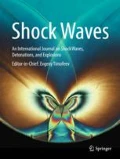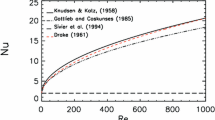Abstract
This paper conducts a numerical study of particle dispersion by vertical shock waves using a combination of computational fluid dynamics and the discrete element method (DEM). The Magnus force is important for particle dispersion, and the DEM approach can consider the rotation of individual particles and provide a detailed analysis of particle–particle and particle–wall interactions. Simulations are conducted and the results are compared with those of previous experiments, showing that the models can capture the particle dispersion process and shock wave geometry inside the mixed gas–particle region. During the particle dispersion process, the contact force due to the particle–particle interactions causes the particles to move upward after the shock wave passes and then decreases rapidly due to the low collision frequency in the particle cloud. The Magnus force is initially lower and has little effect until the contact force decreases, when it becomes dominant and maintains the particles’ upward movement. It is mainly driven by the gas rotation above the dust layer, and the effect of particle rotation is relatively small in comparison. The gas velocity gradient above the dust layer in the particle dispersion region is caused by gas–particle interactions. The particle dispersion region becomes wider and thinner over time, meaning that the gas velocity gradient above the dust layer becomes small and hence that the Magnus force (which is driven by the gas rotation) also becomes small. In contrast, the downward drag force remains constant during the vertical motion because it is primarily affected by the velocity difference between the particles and the gas. This means that the drag and Magnus forces eventually balance, and the particles stop rising.













Similar content being viewed by others
References
Yuan, Z., Khakzad, N., Khan, F., Amyotte, P.: Dust explosions: A threat to the process industries. Process Saf. Environ. Prot. 98, 57–71 (2015). https://doi.org/10.1016/j.psep.2015.06.008
Dawes, J.G.: Safety in Mine Research Establishment. Ministry of Fuel and Power, UK (1952)
Gerrard, J.H.: An experimental investigation of the initial stages of dispersion of dust by shock waves. Br. J. Appl. Phys. 14, 186–192 (1963). https://doi.org/10.1088/0508-3443/14/4/306
Fletcher, B.J.: Interaction of a shock with a dust deposit. J. Phys. D Appl. Phys. 9, 197–202 (1976). https://doi.org/10.1088/0022-3727/9/2/009
Suzuki, T., Adachi, T.: The effects of particles size on shock wave-dust deposit interaction. Proceedings of the 14th International Symposium on Space Technology Science, Tokyo, Japan (1984)
Chowdhury, A.Y., Marks, B.D., Johnston, H.G., Mannan, M.S., Peterson, E.L.: A new facility for studying shock-wave passage over dust layers. Shock Waves 26, 129–140 (2016). https://doi.org/10.1007/s00193-015-0586-z
van der Hoef, M.A., van Sint Annaland, M., Deen, N.G., Kuipers, J.A.M.: Numerical simulation of dense gas-solid fluidized beds: A multiscale modeling strategy. Annu. Rev. Fluid Mech. 40, 47–70 (2008). https://doi.org/10.1146/annurev.fluid.40.111406.102130
Gidaspow, D.: Multiphase Flow and Fluidization: Continuum and Kinetic Theory Descriptions. Academic Press, Boston (1994). https://doi.org/10.1002/aic.690420438
Houim, R.W., Oran, E.S.: Structure and flame speed of dilute and dense layered coal-dust explosions. J. Loss Prev. Process Ind. 36, 214–222 (2015). https://doi.org/10.1016/j.jlp.2015.01.015
Houim, R.W., Oran, E.S.: A multiphase model for compressible granular–gaseous flows: formulation and initial testes. J. Fluid Mech. 789, 166–220 (2016). https://doi.org/10.1017/jfm.2015.728
Ugarte, O.J., Houim, R.W., Oran, E.S.: Examination of the forces controlling dust dispersion by shock waves. Phys. Rev. Fluid 2, 074304 (2017). https://doi.org/10.1103/PhysRevFluids.2.074304
Khmel, T.A., Fedorov, A.V.: Effect of collision dynamics of particles on the processes of shock wave dispersion. Combust. Explos. Shock Waves 52, 207–218 (2016). https://doi.org/10.1134/S0010508216020118
Ishii, M., Hibiki, T.: Thermo-Fluid Dynamics of Two-Phase Flow. Springer, New York (2011). https://doi.org/10.1007/978-1-4419-7985-8
McBride, B., Gordon, S., Reno, M.A.: Coefficient for calculating thermodynamic and transport properties of individual species. NASA Tech. Memo. 4513 (1993)
Gordon, S., McBride, B., Zeleznik, F.J.: Computer program for calculation of complex chemical equilibrium compositions and applications. Supplement 1—Transport properties. NASA Tech. Memo. 86885 (1984)
Theofanous, T., Chan, C.: The dynamics of dense particle clouds subjected to shock waves. Part 2. Modeling/numerical issues and the way forward. Int. J. Multiph. Flow 89, 177–206 (2017). https://doi.org/10.1016/j.ijmultiphaseflow.2016.10.004
Ranz, W.E., Marshall, W.R.: Evaporation from drops. Chem. Eng. Prog. 48, 141–146 (1952)
Ling, Y., Wagner, J.L., Beresh, S.J., Kearney, S.P., Balachandar, S.: Interaction of a planar shock wave with a dense particle curtain: Modeling and experiments. Phys. Fluids 24, 113301 (2012). https://doi.org/10.1063/1.4768815
Parmar, M., Haselbacher, A., Balachandar, S.: Improved drag correlation for spheres and application to shock-tube experiments. AIAA J. 48, 1273–1276 (2010). https://doi.org/10.2514/1.J050161
Sangani, A.S., Zhang, D.Z., Prosperetti, A.: The added mass, Basset, and viscous drag coefficients in nondilute bubbly liquids undergoing small-amplitude oscillatory motion. Phys. Fluids A 3, 2955 (1991). https://doi.org/10.1063/1.857838
Lun, C.K.K., Liu, J.S.: Numerical simulation of dilute turbulent gas-solid flows in horizontal channels. Int. J. Multiph. Flow 23, 575–605 (1997). https://doi.org/10.1016/S0301-9322(96)00087-0
Dennis, S.C.R., Singh, S.N., Ingham, D.B.: The steady flow due to a rotating sphere at low and moderate Reynolds numbers. J. Fluid Mech. 101, 257–279 (1980). https://doi.org/10.1017/S0022112080001656
Sakai, M., Abe, M., Shigeto, Y., Takahashi, H., Vire, A., Percival, J., Xiang, J., Pain, C.: Verification and validation of coarse grain model of the DEM in a bubbling fluidized bed. Chem. Eng. J. 244, 33–43 (2014). https://doi.org/10.1016/j.cej.2014.01.029
Kitamura, K., Shima, E.: Towards shock-stable and accurate hypersonic heating computations: A new pressure flux for AUSM-family schemes. J. Comput. Phys. 245, 62–83 (2013). https://doi.org/10.1016/j.jcp.2013.02.046
Gottlieb, S., Shu, C., Tadmor, E.: Strong stability-preserving high-order time discretization methods. SIAM Rev. 43, 89–112 (2001). https://doi.org/10.1137/S003614450036757X
Tsuji, Y., Morikawa, Y., Mizuno, O.: Experimental measurement of the Magnus force on a rotating sphere at low Reynolds numbers. J. Fluids Eng. 107, 484–488 (1985). https://doi.org/10.1115/1.3242517
Oesterle, B., Dinh, B., Vial, J.L.: Measurements of lift and torque on a rotating sphere at intermediate Reynolds numbers. Mech. Res. Commun. 18, 145–150 (1991). https://doi.org/10.1016/0093-6413(91)90043-V
Acknowledgements
This work was supported by JSPS KAKENHI Grant Number JP18H01387. This work was supported by “Joint Usage/Research Center for Interdisciplinary Large-scale Information Infrastructures” and “High Performance Computing Infrastructure” in Japan. (Project ID: jh160020, hp160183, jh170040, and hp170039). Part of the simulated results in this research was obtained using the supercomputing resources at Cyberscience Center, Tohoku University, Japan.
Author information
Authors and Affiliations
Corresponding author
Additional information
Communicated by A. Higgins.
Publisher's Note
Springer Nature remains neutral with regard to jurisdictional claims in published maps and institutional affiliations.
Rights and permissions
About this article
Cite this article
Shimura, K., Matsuo, A. Two-dimensional CFD–DEM simulation of vertical shock wave-induced dust lifting processes. Shock Waves 28, 1285–1297 (2018). https://doi.org/10.1007/s00193-018-0848-7
Received:
Revised:
Accepted:
Published:
Issue Date:
DOI: https://doi.org/10.1007/s00193-018-0848-7




